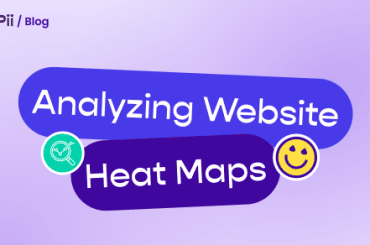Anyone who is running a website knows that they must be attentive to assess all the elements that have the most impact on its visitors. These include your webpage loading time, the design of your website, the content, and more.
Heat maps give you a clear picture of how users interact and behave on your site, you can position the most relevant content on your page where your audience is looking.
These maps are a great resource for understanding how users navigate or do not navigate your pages. If you have a high bounce rate on a particular page, you can use heatmap analysis to understand why people are leaving your page.
In this article, we are going to take a look at heat maps, and what they tell you about your website visitors.
What’s a website heat map ?
A heat map is a tool that performs a visual analysis of user interactions within a website.
It is a tool designed to study the behavior of visitors to a website in order to identify elements of a page that most grab users’ attention.
Several website heat map elements such as eye-tracking, scroll tracking, and click-tracking help to measure these behaviors. It is possible to restore the users’ journey during their navigation using the click tracking tool.
Indeed, it is possible to even know the click rate made on a given point or on a page of your site thanks to the heat map. As for scroll tracking, this heat map tool allows you to trace the movement of the mouse during the consultation of your website.
The representation of this data is quite distinct by highlighting, using patterns or symbols, the cold heat for the points that interested visitors the least, for example.
Analysis performed using heat maps are data gems in increasing the conversions potential of a website.
Examples of website heat maps
Website heat maps are great tools that go hand in hand with building websites to provide web users with content that meets their needs.
In fact, it is not enough to create original content, it is also necessary to place them in appropriate formats and positions to optimize call-to-action strategies in an attractive way.
Examples of website heat maps include:
- Click-tracking
It takes into account the clicks made by users: areas of dark colors such as blue define areas of weak interaction, areas marked with bright colors, such as red, reveal where people’s interest will materialize.
These data sources are very useful for determining where to place calls to action, and for determining if a low conversion rate may be due to a poor location.
- Mouse-movement tracking
The movement flow of the mouse along the page is a sort of parallelism between the movements of the mouse and the eye.
In fact, they are used on the assumption that the eye follows the mouse pointer, and therefore by following the mouse pointer you can identify where the eyes are pointing with this eye-tracking system.
- Scroll-tracking
A scroll-map shows the point at which visitors leave a website as they scroll through the content. The scroll heat map provides insight into how to alter the length of your content and where to place important call-to-actions for maximizing the conversion rate of a landing page.
A study has found that users spend 80% of their time looking at information above the fold and only 20% below it.
- Eye-tracking
This innovative technology is very effective yet it is expensive and more complex to implement for the software and technology involved. It uses the entire subset of visitors’ interactions with a website to determine their eye movement. Applying this technology to larger groups is yet another expensive limitation.
The benefits of using website heat maps
Today, marketing experts are able to measure almost anything, which gives optimizers the opportunity to improve the performance of their marketing campaigns.
Implemented on a website or mobile application, a website heat map allows you to collect data on different design elements:
- Buttons: you can assess the relevance of their placement and their style.
- Navigation: you can see if the menu is understandable, and if the links are correctly placed
- Images: this is also the position, but also the size and type of image that you can test.
- Text: you can assess its formatting, position and length.
- General layout: here is the way in which the elements of your design are hierarchized that you evaluate
By analyzing each of these elements, you will quickly know which ones are performing poorly and which need improvement.
What kind of content can you use website heat maps with?
Analyzing website heat maps of any type of page on your site would be ideal, but unfortunately, it would not be effective.
The most effective way to take advantage of this type of tool is to analyze the pages that most influence your site’s conversion rate: the home page, landing pages, and posts with a high number of conversions.
Advertisement and landing pages
If you are running a display or pay-per-click (PPC) ad, you can use website heat maps to test and analyze the effectiveness of your ad.
With display ads, you can experiment with different elements of your site to see which ones are of the most interest. You can test the color change of your button or the person in your photo.
Website Heat maps will help you compare the two ad displays to see how these changes make people click in different places.
If you’re running a PPC ad, you can use website heat maps to test your landing pages. You can show two different versions of your PPC ad to see which has the most interest and prompts people to click the right buttons or view the right information.
This can be a small test like changing the direction of someone in your ad. In one version, the person may be facing forward, while in the second, they may be text-oriented. With website heat maps, you can see if the person’s position is changing the way people read information on your home page.
Website pages
An important part of your site is the ease of use. You want users to be able to easily navigate and browse your site. With website heat maps, you can analyze changes on your site to see how they help or hinder usability.
You can test whether changing the location of your CTA makes more people take the next step, or if using more visuals makes people scroll further down your page. You can test different elements of your website to see if it creates a better experience for your audience and if they stay engaged on your pages longer.
Content marketing
Content marketing helps you provide your audience with valuable knowledge. One of the most popular forms of content is written content. From blog posts to guides, many companies write this content in the hopes of engaging and informing their audiences.
With website heat maps, you’ll understand how users engage with your content. This is one of the best times to use Heat maps because you’ll know if your content engages your audience and captures their interest.
Website heat maps will help you understand how to create better content for your audience. You’ll see what content your audience scrolls through most of the time throughout the article, so you can create content that is more favorable to them.
Why are people leaving your website?
In order for your website to be successful, it is important that you get as many visitors on the site as possible. However, because there are so many different sites out there competing with yours in terms of content and design, if a potential visitor comes across your page but doesn’t like what they see or find within fifteen seconds then chances are they’ll click away without ever returning again!
Here are 5 reasons why your visitors leave your website:
- Your website takes a long time to load.
You might have the best idea for a service or product, but if your pages are so packed with content and they don’t load quickly then you’ll lose interest. It’s difficult to find anything on web pages nowadays because there is just too much information cluttering it up!
- Bad quality content
Quality content will make your site more interesting and engaging for users. Make sure to keep the text concise, clear, and free of grammatical errors so that it is readable at a glance! Don’t forget about images either; blurry photos can take away from credibility because they are less professional-looking than focused or crisp shots would be.
- Too much ads
A website is a great promotional showcase for your products or services, and it’s important to mention promotions. However, make sure they are relevant to the visitors of your site and related to the content you have posted there!
- Poor website design
The design of your website is what will draw people in and keep them around. Use quality images, eye-catching fonts, and a punchy visual to make sure that the curious never want to leave.
- Unclear message
Transparency is an important consideration when trying to keep people on your site as much as possible. Your product or service offers must be clear and precise. People don’t have the time to “read between the lines” or to figure out what you’re offering for themselves.
Conclusion
Today, marketing experts are able to measure almost anything, which gives us the opportunity to improve the performance of our marketing campaigns.
You will understand that the use of website heat maps is an essential element if you want to optimize the user experience and improve your conversion rates.
By understanding the behavior of your visitors, the areas of attention, the most clicked areas, and the winning paths, you have all the elements in hand to eliminate friction and optimize your website



